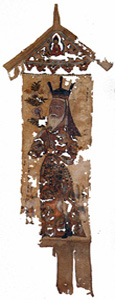

9th century
Found near Khocho
Ink and pigment on ramie
142 x 52 cm
Museum für Indische Kunst, SMPK
Acquisition number: #MIK III 4524
Image courtesy of the Museum für Indische Kunst (copyright reserved)
Staatliche Museen zu Berlin - Preussischer Kulturbesitz
According to Mahayana Buddhist belief, one way to generate religious merit is by helping to finance the decoration of Buddhist temples. It was this belief that helped produce the thousands of mural paintings decorating the cave temples of the Tarim Basin and of Dunhuang. Yet this method of honoring worship sites was expensive and time consuming; also, mural commissions were limited by space available on temple walls. Examples dating to the mid-seventh century have been found with empty cartouches, leading experts to believe that these banners were created on a large scale, to be sold to visitors who would then have the banner inscribed with an appropriate dedication.1
By the ninth century, banner paintings were one of the most popular methods of patronizing Buddhist temples among Uighurs. This example features a double-sided portrait of a Uighur nobleman or prince wearing a three-pronged crown, Uighurian robes and riding boots. The robes are of Chinese silk, a fact determined by the distinctive circular bird patterns woven into the cloth. The banner was most likely created in memorial of the spirit of a departed father, as determined by the inscriptions, one of which in part reads: "For the soul of my (our?) father…"3 As noted in the essay on the Uighur mural fragments, the presence of flowers in the hands of the subject is believed to indicate that the figure portrayed has passed away. Similar flowers painted n the hands of the hands of the nobleman in this painting offers further evidence that the banner was intended to serve as a posthumous memorial portrait.
References:
(1) Along the Ancient Silk Routes: Central Asian Art from the West Berlin State Museums New York: The Metropolitan Museum of Art, 1982), p. 182.
(2) Doitsu Torufan tankengumi: Sai'iki bijutsuten (Tokyo: Tokyo National Museum, 1991), p. 188.
(3) Ibid.